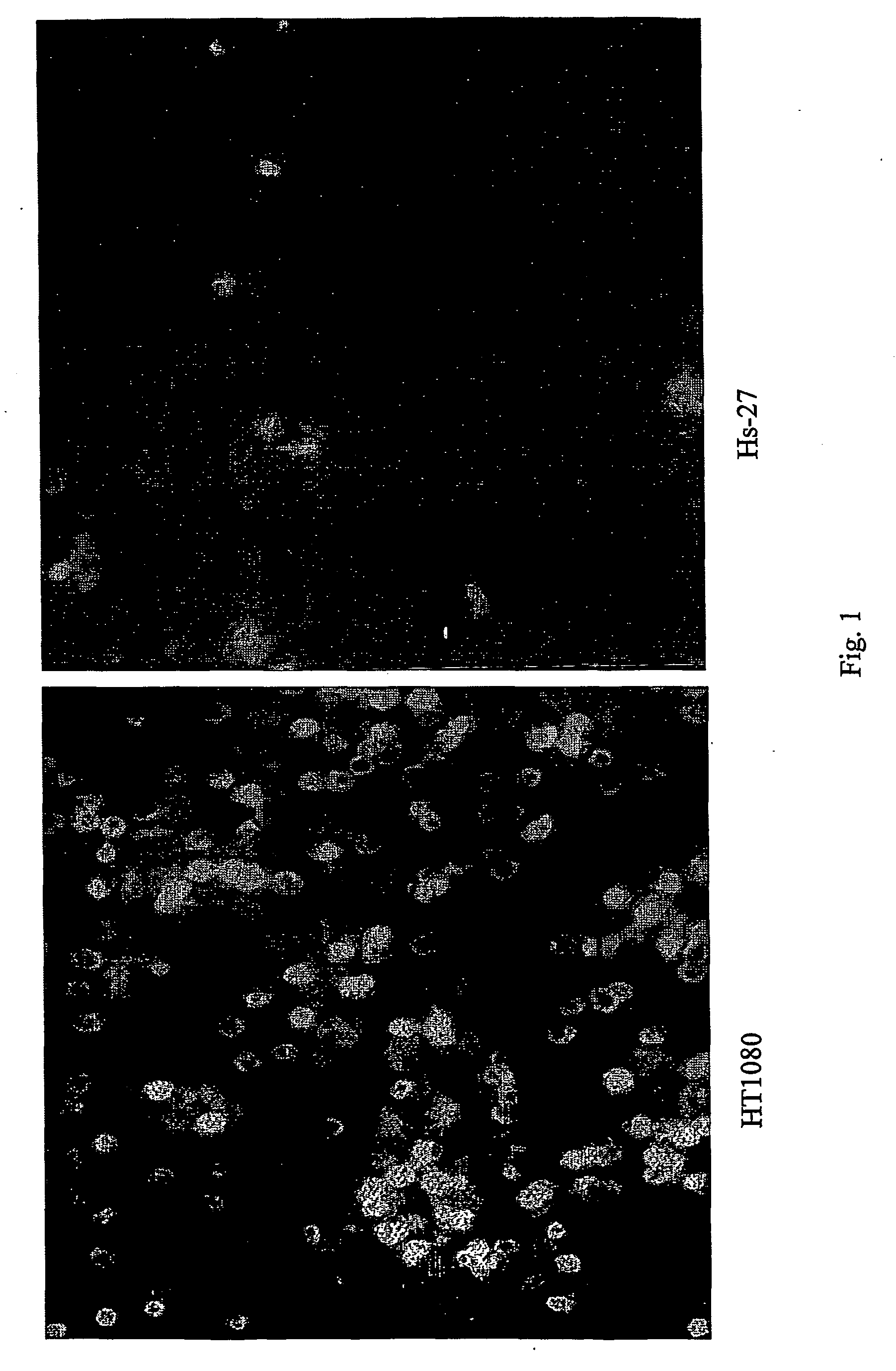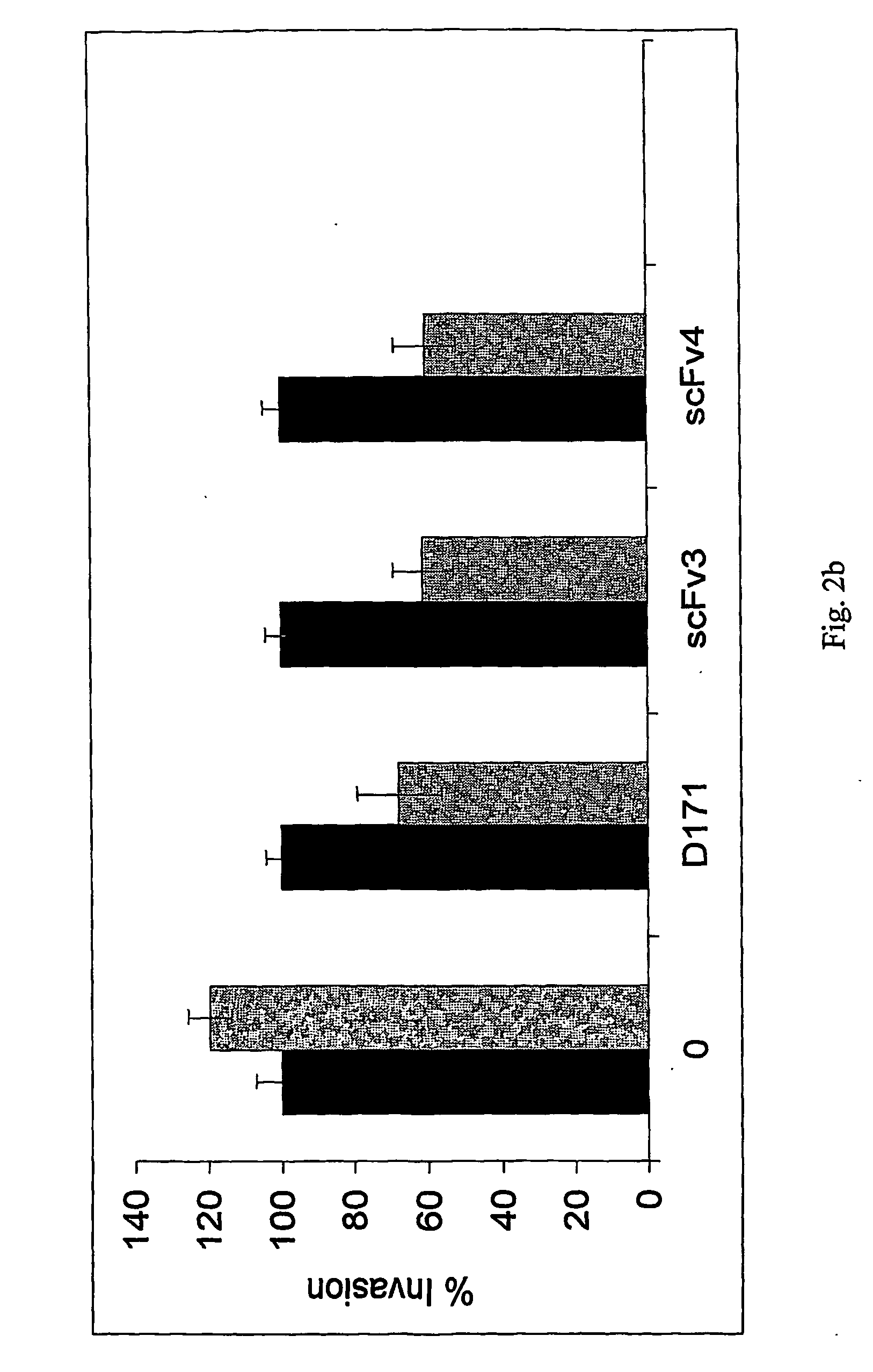Modulation of the poliovirus receptor function
a poliovirus and function technology, applied in the field of poliovirus receptor function modulation, can solve the problems of cell acquisition ability to proliferate and invade host tissues, further prolonging animal survival, and reducing metastasis significantly, so as to improve understanding of the role of pvr and modulate and change physiological pvr function
- Summary
- Abstract
- Description
- Claims
- Application Information
AI Technical Summary
Benefits of technology
Problems solved by technology
Method used
Image
Examples
example 1
Construction of an Immune Library
[0177] Two BALB / c mice were each immunized intradermally with 2×107 paraformaldehyde fixed HT1080 cells (human fibrosarcoma cell line; ATCC, CCL-121). Following the first immunization, the injections were repeated twice in a period of 39 days, the mice sacrificed and the spleens isolated and frozen in liquid nitrogen.
[0178] Total RNA was isolated using the RNeasy Midi Kit (QIAGEN #75142) as described by the manufacturer using half of each spleen preparation. The RNA concentration and purity was determined by a denaturing formaldehyde gel and photometric measurement. cDNA was synthesized using 8.9 μg of freshly prepared RNA and 10 pmol of a primer mix (IgG1-c (SEQ ID NO.: 63), IgG2a-c (SEQ ID NO.: 64), IgG2b-c (SEQ ID NO.: 65), IgG3-c (SEQ ID NO.: 66), VLL-c (SEQ ID NO.: 67), VLK-c (SEQ ID NO.: 68)) using the Superscript™ II Kit (GibcoBRL Life Technologies #18064-014). These primers anneal to the RNA encoding the IgG heavy-chain (VH) genes and the l...
example 2
Selection of Tumor Cell Specific scFv (Selection on Fixed Cells)
[0179] Phages expressing scFv with high affinity to tumor cells were selected as follows: HT1080 cells were harvested with 0.05% EDTA, fixed with paraformaldehyde, diluted to 1×107 cells / ml in PBS and immobilized onto wells of a 96 well UV cross-link plate (Corning Costar). The wells of the UV cross-link plate were blocked with 5% Skim Milk Powder (#70166, Fluka) in PBS (MPBS). 1012 cfu (colony forming units) of phage library / 106 cells were pre-blocked for 1 hour at 25° C. with MPBS and subsequently incubated for 1.5 hour at room temperature (RT) with the cells. The wells of the UV cross-link plate were washed six times with PBS+0.05% Tween-20 followed by six washes with PBS. Bound phage were eluted by the addition of 10 mM Glycine pH 2.2, and neutralized with 1 M Tris / HCl pH 7.4. Typically, between 103 and 106 cfu were eluted in the 1st round of selection, thus the diversity of the enriched repertoire is decreased com...
example 3
Screening of scFv (Screening on Fixed Cells)
[0180] For screening, the genes encoding the selected scFv, contained in the phage display vector, were re-cloned to the expression vector pXP14 (SEQ ID No.: 8). This vector directs the expression of scFv in fusion with a Strep-tag and E-tag and does not contain a filamentous phage gene-3. Expression vector containing E. coli TG1 from single colonies were grown in individual wells of a micro titer plate so that each well contains only one scFv clone. The bacteria were grown at 30° C. in 2×TY supplemented with 100 μg / ml ampicillin and 0.1% glucose in 96-well micro titer plates (#9297, TPP) until an OD600 of 0.7. Expression was induced with IPTG at a final concentration of 0.5 mM and continued at 25° C. overnight. Single chain Fv containing cleared lysates were prepared by addition of hen-egg lysozyme (#L-6876, Sigma) to a final concentration of 50 μg / ml for 1 hour at 25° C. and centrifugation for 15 minutes at 3000×g. Prior to the screenin...
PUM
| Property | Measurement | Unit |
|---|---|---|
| Adhesion strength | aaaaa | aaaaa |
Abstract
Description
Claims
Application Information
 Login to View More
Login to View More - R&D
- Intellectual Property
- Life Sciences
- Materials
- Tech Scout
- Unparalleled Data Quality
- Higher Quality Content
- 60% Fewer Hallucinations
Browse by: Latest US Patents, China's latest patents, Technical Efficacy Thesaurus, Application Domain, Technology Topic, Popular Technical Reports.
© 2025 PatSnap. All rights reserved.Legal|Privacy policy|Modern Slavery Act Transparency Statement|Sitemap|About US| Contact US: help@patsnap.com



